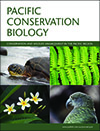
Pacific Conservation Biology
Volume 27 Number 2 2021
We reviewed marine and coastal ecosystem-based adaptation (EbA) termed projects across Asia and Oceania. Our aim was to clarify where, why and how EbA has been implemented and examine the degree to which EbA has been integrated with marine spatial planning (MSP). We found that EbA was widely used in developing countries, largely in mangroves and commonly implemented to target ecosystem services that help people adapt to extreme events and sea level rise. We also identify and discuss common features in EbA projects that incorporate best practice MSP.
PC20025 Abstract | PC20025 Full Text | PC20025PDF (1.1 MB) | PC20025Supplementary Material (377 KB) Open Access Article
Australia has just experienced an unparalleled (2019–2020) fire season in terms of the extent of areas burned and losses of biodiversity. This article, based on the 2020 Krebs lecture, discusses some of the key themes on wildfires in forests and their effects on fauna.
PC20002Linking social and biophysical systems to inform long-term, strategic management of coral reefs
 , Russell Gorddard, Pedro Fidelman, Kate J. Helmstedt, Kenneth R. N. Anthony, Kerrie A. Wilson and Hawthorne L. Beyer
, Russell Gorddard, Pedro Fidelman, Kate J. Helmstedt, Kenneth R. N. Anthony, Kerrie A. Wilson and Hawthorne L. Beyer
Climate change is a key driver of global coral reefs decline, with current management practices are expected to be insufficient in a changing world. Long-term strategic planning is needed to reduce risks of failure in coral reef conservation. Adaptation Pathways are a promising decision approach to develop a shared view of the changing systems and challenges for the conservation of coral reefs.
George Seddon’s 1972 book, ‘Sense of Place’, was a landmark publication that revolutionised our understanding of Perth’s place in the Swan Coastal plain and cemented the term in the fields of landscape architecture and environmental design. Since then, Perth has grown enormously in size, destroying in the process, so much of the unique ancient vegetation carefully documented by George. We now battle with problems of congestion, increasing temperatures, dwindling water supply, and for our own survival we need to recover our lost ‘sense of place’.
This study describes the processes of mating, colony formation, habitat preferences, egg-laying and incubation periods, post-hatching care, and breeding success of the Australian Fairy Tern, Sternula nereis nereis, in south-western Australia. This research informs conservation strategies for this threatened species, where management interventions are frequently necessary to prevent population decline.
Insectivorous bats make a significant contribution to mammalian diversity in central Australia, with 12 known extant species, yet little is known about their habitat preferences and how these interact with temporal patterns in their abundance and activity. We found that bat activity was higher in arid riparian woodland than in nearby vegetation, and this difference was most significant during a hot and dry summer. Our findings demonstrate the importance of riparian woodlands to bats in an arid environment, particularly during low-resource periods
Toxoplasma gondii is a parasite causing disease in endangered marine mammals. We used seropositivity in chickens on the island Kaua’i to detect T. gondii and found it present at nearly every site. Proximity to the coast also significantly predicted T. gondii seropositivity. Our data supports island-wide mitigation to prevent environmental contamination of T. gondii.
PC19052The impact of ebony wood harvesting on Diospyros samoensis (Ebenaceae) on Vangunu Island, Western Solomon Islands
Ebony heartwood of some trees is used to produce high-value carvings in the Pacific, with supplies reportedly declining. While the source species, Diospyros samoensis, is not currently threatened with extirpation, poor harvesting practices cause severe damage to trees and reduce regeneration. Scarce ebony heartwood supplies do not equate to rarity of D. samoensis but implementing sustainable harvesting practices could avoid long-term population declines.
The objective of this study was to determine whether different types of abundance data would influence predictions from species distribution models. We found that two of the most common data types for monitoring feral pigs highly correlate in their spatial predictions at a landscape scale and would likely inform similar management recommendations.
PC20032 Abstract | PC20032 Full Text | PC20032PDF (753 KB) Open Access Article
PC20022Automated shepherds: responses of captive dingoes to sound and an inflatable, moving effigy
We tested two potential non-lethal deterrents on dingoes and found that an inflatable effigy device was effective at preventing dingo approaches to food during initial exposure. We recommend that devices such as this continue to be developed and tested as methods for managing human–dingo conflict, and promoting human–carnivore coexistence.



